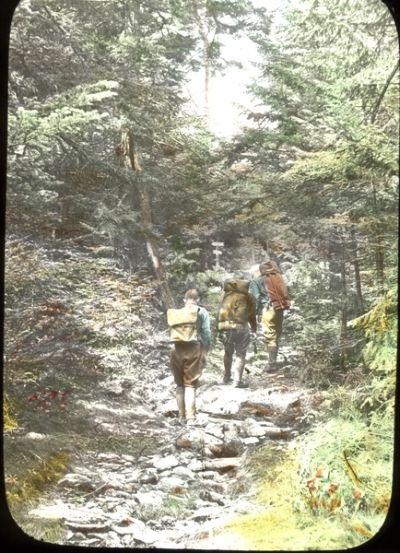Visit the Series Homepage
The Long Trail: Vermont’s Footpath Through History

(Host) In our series "The Long Trail: Vermont’s Footpath Through History," we’re looking at some of the milestones in the trail’s 100 year history.
Today we return to the 1930s, when the Long Trail faced its biggest threat, and the Green Mountain Club was forced to reconsider its purpose.
As VPR Commentator Tom Slayton explains, that’s when the club faced its biggest turning point.
(Slayton) Probably the greatest threat to the integrity of the Green Mountains – and the Long Trail which traverses them – was the Green Mountain Parkway. Had it been built, there would now be a high-elevation highway threading its way among Vermont’s highest peaks.
The road was first proposed in 1934, when the Great Depression was crushing the life out of the American economy. It was modeled after the Blue Ridge Parkway in Virginia, and promoters of the road thought it could help Vermont emerge from the Depression – and attract tourists’ cars and tourist dollars to the Green Mountains as well.
Vermont Historical Society Librarian Paul Carnahan says many people thought Depression-era Vermont would benefit from the highway:
(Carnahan) "It was proposed to, for several reasons, primarily to take advantage of the federal money that was available at that time during Roosevelt’s New Deal, a lot of building projects going on across the United States. There were several boosters in Vermont, especially a man by the name of James Wilgus who was a highway engineer."
(Slayton) But the Parkway quickly generated plenty of opposition from those who loved the mountains, and those who distrusted the federal government. The proposal split both Vermont and the Green Mountain Club deeply. It was furiously debated for more than two years.
And it provided the club – which built, maintains, and protects the Long Trail – with a huge historical irony, because its founder, James Paddock Taylor, who originated both the Green Mountain Club and the idea of the Long Trail, was firmly in favor of the Green Mountain Parkway.
Taylor helped lead the charge because he had become head of the Vermont Chamber of Commerce, and, like many progressive people of his day, saw the Parkway as a means of pulling Vermont out of poverty.
Paul Carnahan notes that Taylor, the founder of the Green Mountain Club, was a natural at promotion. And he liked the Parkway proposal:
(Carnahan) "Vermont at this time had many miles of substandard roads, and so he was busy promoting the improvement of the roads, and he was also promoting the natural beauty of the state. I mean, he was one of the first people who saw Vermont’s natural resources as something to market to an outside world."
(Slayton) Many thought that building the 270-mile highway through the Green Mountains would provide jobs for Vermont construction workers, while the road itself would make Vermont a tourist attraction.
But other Vermonters were not so sure. The powerful Proctor family opposed the road, and Professor Arthur Wallace Peach, then head of the Vermont Historical Society declared that there were no shortcuts to heaven, "not even a parkway!"
The Burlington Free Press favored the highway, while the Rutland Herald opposed it. In fact, it split Vermont and split the Green Mountain Club, as Historical Society librarian Carnahan notes:
(Carnahan) "I think those who opposed it saw it as an intrusion into the natural beauty of the…of the state, and of the, the long-planned and worked-on Long Trail. Those in favor of it, I think, saw it as sort of a…a democratizing effort to bring more people out into the..into the wilderness and to enjoy the, the benefits of mountain vistas and things like that."
(Slayton) As we know today, the Green Mountain Parkway was never built. In a statewide referendum on Town Meeting Day, 1936, Vermonters sharply rejected the proposal by more than 12,000 votes. There are some today who say that Vermont’s Interstate highways have had about the same effects – both for good and ill – that the Green Mountain Parkway might have had.
But the decision turned the Green Mountain Club away from development and toward environmental conservation. In the years since that 1936 decision, the club has emerged as a primary defender of the wild beauty and environmental wholeness of the mountains. Even in the 1970s and 80s, when hordes of backpacking hikers became a destructive force, the Green Mountain Club established policies to protect the fragile mountaintops, the trail and the forest. Through the years, it has consistently worked to protect the Long Trail and the high mountain lands that surround it.
And, significantly, it was a major threat – the proposed Green Mountain Parkway – that helped the club define its environmental role and become advocates for the mountains that all Vermonters love.
(Host Outro) Tom Slayton is editor emeritus of Vermont Life and editor of "A Century in the Mountains."
Visit the Series Homepage